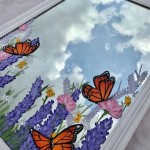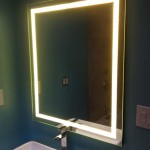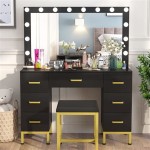Mirror, Mirror, Clear and Bright: Understanding Anti-Fog Technologies
Mirrors are commonplace fixtures in modern life, serving both functional and aesthetic purposes in bathrooms, vehicles, and a myriad of other settings. However, their utility is often compromised by fogging, a phenomenon caused by the condensation of water vapor on the mirror's surface. This condensation arises when the warm, moist air encounters the cooler surface of the mirror, causing the water vapor to transition into liquid droplets. The resulting film of water droplets scatters light, rendering the mirror opaque and obscuring the reflected image. The ongoing challenge of combating mirror fog has led to the development of various anti-fog technologies, each with its own principles of operation, effectiveness, and applications.
The fundamental principle behind anti-fog technologies is to prevent or minimize the formation of water droplets on the mirror's surface. This can be achieved through two primary strategies: increasing the surface temperature of the mirror to prevent condensation from occurring, or modifying the surface properties of the mirror to promote the formation of a thin, uniform film of water instead of discrete droplets. The choice of anti-fog technology depends on factors such as cost, energy consumption, ease of installation, and the desired level of performance. Understanding the mechanisms underlying these technologies is crucial for making informed decisions about their application in different contexts.
Heated Mirrors: A Thermal Approach to Fog Prevention
Heated mirrors represent a direct and effective solution to the problem of fogging. These mirrors incorporate a heating element, typically a thin resistive film or a network of wires embedded within the mirror assembly. When activated, the heating element generates heat, raising the surface temperature of the mirror above the dew point of the surrounding air. The dew point is the temperature at which water vapor in the air will begin to condense. By maintaining the mirror's surface temperature above this point, condensation is prevented, and the mirror remains clear.
Heated mirrors are commonly found in automotive applications, particularly in side-view mirrors. In cold or humid conditions, the heating element can be activated to ensure clear visibility, enhancing driver safety. In residential bathrooms, heated mirrors offer a convenient solution for maintaining a clear reflection after showers or baths. These mirrors are typically wired to the bathroom's electrical system and can be activated via a switch or integrated into the bathroom's lighting circuit.
The effectiveness of heated mirrors depends on the power output of the heating element and the ambient temperature and humidity levels. In extremely cold or humid environments, a higher power output may be required to maintain the mirror's surface temperature above the dew point. The energy consumption of heated mirrors can be a concern, particularly if they are left on for extended periods. However, many modern heated mirrors incorporate automatic shut-off timers or thermostatic controls to minimize energy waste. The installation of heated mirrors typically requires electrical work, which may necessitate the involvement of a qualified electrician.
Hydrophilic Coatings: Altering Surface Wettability
Hydrophilic coatings represent an alternative approach to combating mirror fogging. These coatings work by modifying the surface properties of the mirror, making it more attractive to water. A hydrophilic surface has a high affinity for water, causing water droplets to spread out and form a thin, uniform film instead of discrete droplets. This film of water is transparent and does not scatter light, allowing for a clear reflection.
The effectiveness of hydrophilic coatings depends on their ability to maintain their hydrophilic properties over time and under varying environmental conditions. Some coatings may degrade or become contaminated, reducing their effectiveness. The application of hydrophilic coatings can also influence the mirror's reflectance, potentially affecting the brightness and clarity of the reflected image.
Hydrophilic coatings are typically applied as a thin layer to the mirror's surface using techniques such as spraying, dipping, or spin coating. The coating material often consists of polymers, surfactants, or nanoparticles that possess hydrophilic properties. One common example is titanium dioxide (TiO2), a photocatalytic material that exhibits superhydrophilicity when exposed to ultraviolet (UV) light. When exposed to UV light, TiO2 generates electron-hole pairs, which react with water molecules in the air to form hydroxyl radicals. These hydroxyl radicals break down organic contaminants on the mirror's surface, maintaining its hydrophilic properties. Hydrophilic coatings offer a cost-effective and energy-efficient solution for preventing mirror fogging in a variety of applications. They are commonly used in bathroom mirrors, automotive windshields, and eyeglasses.
Anti-Fog Films: A Flexible and Removable Solution
Anti-fog films provide a flexible and removable solution for preventing mirror fogging. These films are typically made of a thin, transparent plastic material coated with an anti-fog substance. The anti-fog substance can be either a hydrophilic coating, promoting the formation of a thin film of water, or a moisture-absorbing material, preventing condensation from occurring in the first place. Anti-fog films are applied to the mirror's surface using an adhesive backing. They offer a convenient and cost-effective solution for retrofitting existing mirrors with anti-fog capabilities.
The effectiveness of anti-fog films depends on the quality of the film material, the adhesive used, and the anti-fog substance applied. Over time, the film may degrade or become damaged, reducing its effectiveness. The adhesive may also lose its grip, causing the film to peel off. Proper installation and maintenance are crucial for ensuring the longevity and performance of anti-fog films. Before installation, the mirror surface needs to be cleaned thoroughly to remove any dirt, dust, or grease. The film should be applied carefully to avoid trapping air bubbles, which can detract from the mirror's clarity. Anti-fog films are commonly used in bathroom mirrors, shower doors, and automotive windshields. They are particularly useful in applications where a permanent anti-fog solution is not feasible or desired.
Furthermore, the longevity of anti-fog films can vary depending on the environmental conditions they are exposed to. High humidity and temperature fluctuations can accelerate the degradation of the film and the adhesive. Regular cleaning with a mild, non-abrasive cleaner can help to maintain the film's clarity and effectiveness. It is important to avoid using harsh chemicals or abrasive cleaners, as these can damage the film's coating and reduce its anti-fog properties.
In summary, a range of anti-fog technologies are available to address the common problem of mirror fogging. Heated mirrors offer a direct and effective solution by raising the mirror's surface temperature above the dew point. Hydrophilic coatings modify the surface properties of the mirror, promoting the formation of a thin, uniform film of water. Anti-fog films provide a flexible and removable solution for retrofitting existing mirrors with anti-fog capabilities. Each technology has its own advantages and disadvantages, and the choice of which technology to use depends on factors such as cost, energy consumption, ease of installation, and the desired level of performance. As nanotechnology and materials science continue to advance, new and improved anti-fog technologies are likely to emerge, further enhancing the clarity and functionality of mirrors in a variety of applications.

Ktaxon Anti Fog Wall Mounted Lighted Vanity Mirror Led Bathroom And Ip67 Waterproof Rectangle 40 X24 Silver Com

Toolkiss 48 In W X 36 H Large Rectangular Frameless Led Light Anti Fog Wall Bathroom Vanity Mirror Super Bright Tk19068 The Home Depot

Waterpar Super Bright 40 In W X 32 H Rectangular Frameless Anti Fog Led Wall Bathroom Vanity Mirror With Front Light Wp024 The Home Depot

Toolkiss 48 In W X 36 H Rectangular Frameless Led Light Anti Fog Wall Bathroom Vanity Mirror With Backlit And Front Tk19268 The Home Depot

Zimtown Light Strip Touch Led Bathroom Mirror Anti Fog 36x28 In Rectangle Wall Mounted Silver Com

Toolkiss 40 In W X 32 H Rectangular Frameless Led Light Anti Fog Wall Bathroom Vanity Mirror With Backlit And Front Tk23607 The Home Depot

High Class Large Round Led Mirror Anti Fog Bathroom Entryway Desk W Strap

Homlux 36 In W X 30 H Rectangular Frameless Led Light With 3 Color And Anti Fog Wall Mounted Bathroom Vanity Mirror 99c300479c The Home Depot

Blanca Led Bathroom Mirror Large Size Rectangular Anti Fog Memory Dimmable Touch Sensor Horizontal Vertical White Daylight Lights The Pop Home Target

Dental Automatic Anti Fog Mirrors For Oral Photography Reflector Defog








